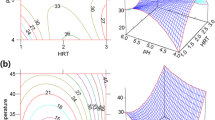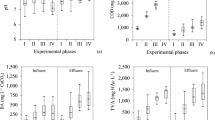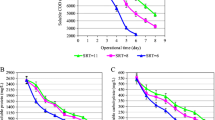Abstract
To investigate the effect of hydraulic retention time (HRT) and temperature (T) on bacterial community structure and volatile fatty acids (VFAs) production of an acidogenic process, and VFA production and changes in the bacterial community in three identical automated anaerobic continuously-stirred tank reactors were analyzed using response surface analysis (RSA) and nonmetric multidimensional scaling (NMDS). For RSA, 11 trials were conducted to find the combination of T and HRT under which VFA production was greatest; VFA production was affected more by HRT than by T. To identify the bacterial community structure in each trial, DNA from each experimental point of the RSA was analyzed using denaturating gradient gel electrophoresis (DGGE), and eight bacteria species were detected. NMDS was conducted on band intensities obtained using DGGE, and bacterial community structure was affected more by T than by HRT. Taken together, these results suggest that VFA production during acidogenesis was more dependent on the physicochemical properties of acidogens, such as their specific growth rate or contact time with of substrates, than on changes in the microbial community.


Similar content being viewed by others
Abbreviations
- ANOVA:
-
Analysis of variance
- COD:
-
Chemical oxygen demand
- CSTR:
-
Continuously stirred tank reactors
- DDW:
-
Deionized and distilled water
- DGGE:
-
Denaturating gradient gel electrophoresis
- HRT:
-
Hydraulic retention time
- NMDS:
-
Nonmetric multidimensional scaling
- OD:
-
Optical density
- RSA:
-
Response surface analysis
- RSM:
-
Response surface methodology
- sCOD:
-
Soluble chemical oxygen demand
- T:
-
Temperature
- TS:
-
Total solids
- TSS:
-
Total suspended solids
- TVFA:
-
Total volatile fatty acids
- UPGMA:
-
Unweighed pair group method with arithmetic
- VFA:
-
Volatile fatty acid
- VS:
-
Volatile solids
- VSS:
-
Volatile suspended solids
References
Beaudet R, Gagnon C, Bisaillon JG, Ishaque M (1990) Microbiological aspects of aerobic thermophilic treatment of swine waste. Appl Environ Microbiol 56:971–976
Speece RE (1996) Anaerobic Biotechnology for Industrial Wastewaters. Archae Press, Nashville
Ueno Y, Haruta S, Ishii M, Igarashi Y (2001) Changes in product formation and bacterial community by dilution rate on carbohydrate fermentation by methanogenic microflora in continuous flow stirred tank reactor. Appl Microbiol Biotechnol 57:65–73
Hwang K, Song M, Kim W, Kim N, Hwang S (2010) Effects of prolonged starvation on methanogenic population dynamics in anaerobic digestion of swine wastewater. Bioresource Technol 101(Suppl 1):S2–S6
Song M, Shin SG, Hwang S (2010) Methanogenic population dynamics assessed by real-time quantitative PCR in sludge granule in upflow anaerobic sludge blanket treating swine wastewater. Bioresource Technol 101:S23–S28
Kim W, Lee S, Shin SG, Lee C, Hwang K, Hwang S (2010) Methanogenic community shift in anaerobic batch digesters treating swine wastewater. Water Res 44:4900–4907
Stronach SM, Rudd T, Lester JN (1986) Anaerobic digestion processes in industrial wastewater treatment. Springer, New York
Aitken MD, Mullennix RW (1992) Another look at thermophilic anaerobic digestion of wastewater sludge. Water Environ Res 64:915–919
Yilmaz T, Yuceer A, Basibuyuk M (2008) A comparison of the performance of mesophilic and thermophilic anaerobic filters treating papermill wastewater. Bioresource Technol 99:156–163
Curtis TP, Sloan WT (2004) Prokaryotic diversity and its limits: microbial community structure in nature and implications for microbial ecology. Curr Opin Microb 7:221–226
Kim W, Hwang K, Shin SG, Lee S, Hwang S (2010) Effect of high temperature on bacterial community dynamics in anaerobic acidogenesis using mesophilic sludge inoculum. Bioresource Technol 101(Suppl 1):S17–S22
Curtis TP, Craine NG (1993) The comparison of the diversity of activated sludge plants. Water Sci Technol 137:71–78
Hwang S, Lee Y, Yang K (2001) Maximization of acetic acid production in partial acidogenesis of swine wastewater. Biotechnol Bioeng 75:521–529
Yang K, Oh C, Hwang S (2004) Optimizing volatile fatty acid production in partial acidogenesis of swine wastewater. Water Sci Technol 50:169–176
Lee H, Song M, Yu Y, Hwang S (2003) Production of Ganoderma lucidum mycelium using cheese whey as an alternative substrate: response surface analysis and biokinetics. Biochem Eng J 15:93–99
Box GEP, Draper NR (1987) Empirical model-building and response surfaces. Wiley, New York
Hwang SH, Hansen CL, Stevens DK (1992) Biokinetics of an upflow anaerobic sludge blanket reactor treating whey permeate. Bioresource Technol 41:223–230
Yu Y, Kim J, Hwang S (2006) Use of real-time PCR for group-specific quantification of aceticlastic methanogens in anaerobic processes: population dynamics and community structures. Biotechnol Bioeng 93:424–433
Obata K, Segawa O, Yakabe M, Ishida Y, Kuroita T, Ikeda K, Kawakami B, Kawamura Y, Yohda M, Matsunaga T, Tajima H (2001) Development of a novel method for operating magnetic particles, magtration technology, and its use for automating nucleic acid purification. J Biosci Bioeng 91:500–503
Yu Y, Lee C, Hwang S (2005) Analysis of community structures in anaerobic processes using a quantitative real-time PCR method. Water Sci Technol 52:85–91
Muyzer G, De Waal EC, Uitterlinden AG (1993) Profiling of complex microbial populations by denaturing gradient gel electrophoresis analysis of polymerase chain reaction-amplified genes coding for 16S rRNA. Appl Environ Microbiol 59:695–700
Kowalchuk GA, de Bruijn FJ, Head IM, Antoon D, Akkermans L, Van Elsas JD (2004) Molecular microbial ecology manual. Academic Publishers, Dordrecht
Roy CS, Talbot G, Topp E, Beaulieu C, Palin MF, Masse DI (2009) Bacterial community dynamics in an anaerobic plug-flow type bioreactor treating swine manure. Water Res 43:21–32
Fromin N, Hamelin J, Tarnawski S, Roesti D, Jourdain-Miserez K, Forestier N, Teyssier-Cuvelle S, Gillet F, Aragno M, Rossi P (2002) Statistical analysis of denaturing gel electrophoresis (DGE) fingerprinting patterns. Environ Microbiol 4:634–643
APHA-AWWA-WEF (2005) Standard Methods for the examination of water and wastewater, 21st Ed., American Public Health Association, Washinton, DC
Takami H, Horikoshi K (1999) Reidentification of facultatively alkaliphilic Bacillus sp. C-125 to Bacillus halodurans. Biosci Biotech Biochem 63:943–945
Patil S, Kumar M, Ball A (2010) Microbial community dynamics in anaerobic bioreactors and algal tanks treating piggery wastewater. Appl Microbiol Biotechnol 87:353–363
Székely A, Sipos R, Berta B, Vajna B, Hajdú C, Márialigeti K (2009) DGGE and T-RFLP analysis of bacterial succession during mushroom compost production and sequence-aided T-RFLP profile of mature compost. Microb Ecol 57:522–533
Shiratori H, Ohiwa H, Ikeno H, Ayame S, Kataoka N, Miya A, Beppu T, Ueda K (2008) Lutispora thermophila gen. nov., sp. nov., a thermophilic, spore-forming bacterium isolated from a thermophilic methanogenic bioreactor digesting municipal solid wastes. Int J Syst Evol Microbiol 58:964–969
Alves MP, Rainey FA, Nobre MF, da Costa MS (2003) Thermomonas hydrothermalis sp. nov., a new slightly thermophilic gamma-proteobacterium isolated from a hot spring in central Portugal. Syst Appl Microbiol 26:70–75
Busse HJ, Kämpfer P, Moore ERB, Nuutinen J, Tsitko IV, Denner EBM, Vauterin L, Valens M, Rosselló-Mora R, Salkinoja-Salonen MS (2002) Thermomonas haemolytica gen. nov., sp. nov., a γ-proteobacterium from kaolin slurry. Int J Syst Evol Micr 52:473–483
Lee YJ, Romanek CS, Mills GL, Davis RC, Whitman WB, Wiegel J (2006) Gracilibacter thermotolerans gen. nov., sp. nov., an anaerobic, thermotolerant bacterium from a constructed wetland receiving acid sulfate water. Int J Syst Evol Micr 56:2089–2093
Lee C, Kim J, Hwang K, O’Flaherty V, Hwang S (2009) Quantitative analysis of methanogenic community dynamics in three anaerobic batch digesters treating different wastewaters. Water Res 43:157–165
Gummadi S, Santhosh D (2010) Kinetics of growth and caffeine demethylase production of Pseudomonas sp. in bioreactor. J Ind Microbiol Biotechnol 37:901–908
Acknowledgments
This work was supported by the Advanced Biomass R&D Center (ABC) of Global Frontier Project funded by the Ministry of Education, Science and Technology (ABC-2010-0029728), and was also the New & Renewable Energy of the Korea Institute of Energy Technology Evaluation and Planning(KETEP) grant funded by the Korea government Ministry of Knowledge Economy (Grant no. 20103020090050).
Author information
Authors and Affiliations
Corresponding author
Rights and permissions
About this article
Cite this article
Kim, W., Shin, S.G., Lim, J. et al. Effect of temperature and hydraulic retention time on volatile fatty acid production based on bacterial community structure in anaerobic acidogenesis using swine wastewater. Bioprocess Biosyst Eng 36, 791–798 (2013). https://doi.org/10.1007/s00449-013-0905-7
Received:
Accepted:
Published:
Issue Date:
DOI: https://doi.org/10.1007/s00449-013-0905-7




